Additional notes (click to expand)
Commemorative
This shrubby, fragrant, white-flowered honeysuckle is named for Adam Lonitzer (Lonicerus) (1528–86). A German botanist, physician and author of the botanical herbal Naturalis historiae opus novum (vol 1 in 1551, vol 2 in 1555) and its German translation, the Kreuterbuch (1557) (sourced
mainly from earlier herbals), he became professor of mathematics at the University of Marburg in 1553 and doctor of medicine in 1554, working in Frankfurt-am-Main. His wife was the daughter of
the Frankfurt publisher, Christian Egenolff, who published his book along with other herbals. Adam’s father, Johann Lonitzer (Joanne Lonicerus) (1499–1569), was professor of theology and ancient languages and contributed the Greek, Hebrew, Latin and German names of plants to
Ruellio’s commentary on Dioscorides (edition of 1543) published by Egenolff.
Oakeley, Dr. Henry. (2012). Doctors in the Medicinal Garden. Plants named after physicians. Royal College of Physicians. page 106
link
Horticulture
A bushy, spreading, deciduous or semi-evergreen shrub with paired, oval leaves, to 7cm (3in) long, dull, dark green above, blue-green beneath, with bristly margins when young. Tubular, 2-lipped, very fragrant, creamy white flowers, 1cm long, are produced in pairs from the leaf axils in winter and early spring. Berries are dull red. It grows to 2m (6ft) high by 3m (10ft) wide.
Full hardy. Grow in any well-drained soil in full sun or partial shade. Sow seed of hardy species in containers in a cold frame as soon as ripe. Alternatively, semi-ripe cuttings can be taken in summer. Aphids may be a problem.
Brickell, C. (2003). A-Z Encyclopedia of Garden Plants. Dorling Kindersley. p.651
In the Medicinal Garden it grows well in a deep, raised bed of fertile soil in the partial shade of a London Plane tree. It is mulched annually with well-rotted manure and pruned in spring after flowering by removing older wood to the base. (Clare Beacham)
Other use
Lonicera fragrantissima was introduced to Europe from China in the early 1840s by the British plant collector Robert Fortune, working for the Royal Horticultural Society. We also grow Lonicera periclymenum, our familiar climbing honeysuckle, but the honeysuckle of Dioscorides may have been Lonicera etrusca, which he called clymenon. He recommended the fruit, dried and drunk in wine for 40 days, to ‘reduce the spleen, abate fatigue, orthopnea [breathlessness on lying fl at], and hiccoughs, but from the sixth day it makes the urine bloody’ (Beck, 2005). Dioscorides also reported that it speeded up labour, made people sterile after drinking it for 37 days, and reduced the shivering of intermittent fevers if rubbed on with olive oil. Dioscorides is clearly indicating that the berries are poisonous and there must be few people who would put up with haematuria for over a month to cure hiccoughs. Johnson (1633), using the name Periclymenum, woodbinde or honisuckles, repeats Dioscorides, but adds that the flowers stop ‘pissing of blood’ and can be used for soreness of the throat and ‘the secret parts’. Modern literature (Frohne, 2004) reports that honeysuckles are poisonous and herbals note the induction of vomiting with berries, and purgation with the leaves – a sure sign of toxicity. Sucking the nectar from the flowers appears acceptable.
◼
Oakeley, Dr. Henry. (2012). Doctors in the Medicinal Garden. Plants named after physicians. Royal College of Physicians.
link
Geographical distribution
- Asia-Temperate, China
Lonicera fragrantissima Lindl. & Paxton
Family: CAPRIFOLIACEAEGenus: Lonicera
Species: fragrantissima Lindl. & Paxton
Common names: Winter-flowering Honeysuckle
Distribution summary: China
Habit: Shrub
Hardiness: H5 - Hardy; cold winter
Habitat: Rocky slopes, scrub & light woodland
Garden status: Currently grown
Garden location: Plants of the World (C)
Flowering months: January, February
Reason for growing: Commemorative
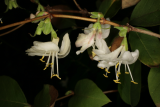
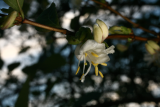
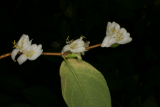
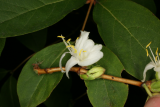
.jpg)
.jpg)
.jpg)
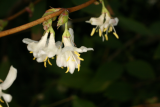
.JPG)
.JPG)
.jpg)
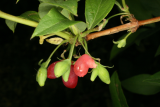
 fruit.JPG)
 fruit.JPG)
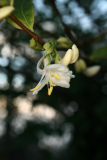
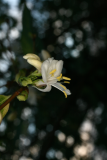
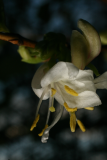
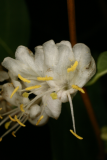
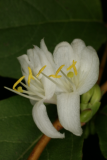
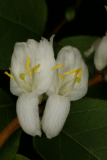
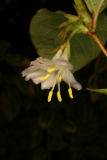
.JPG)